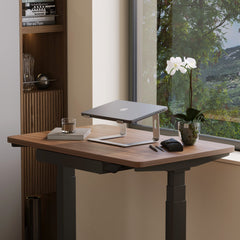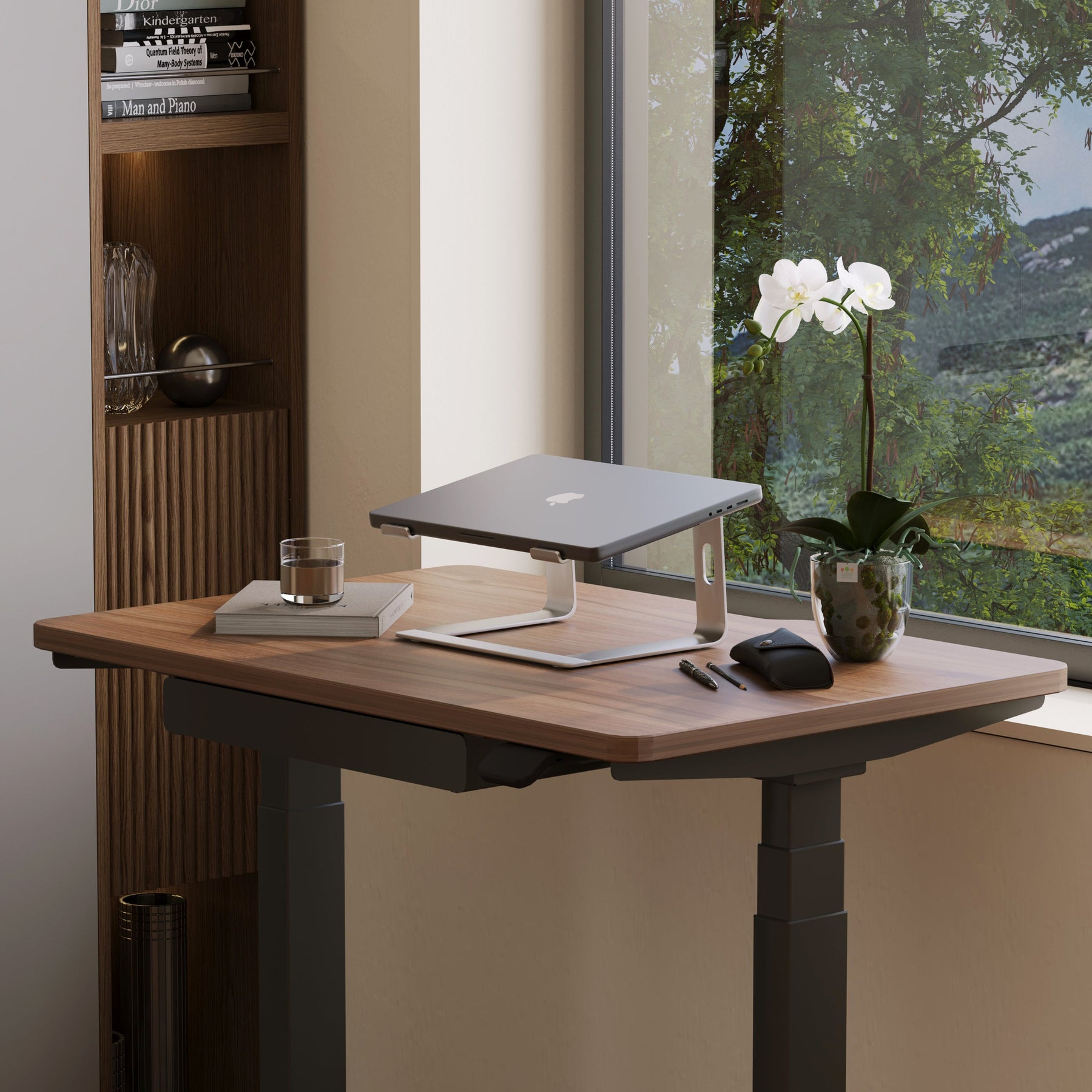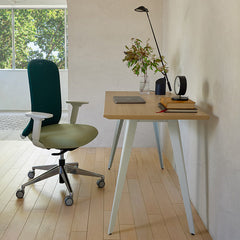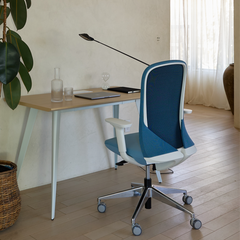Get 10% off your first order
Find the office furniture that’s designed to match your style, comfort, and needs perfectly. Subscribe
Hidden Hazards: 5 Ergonomic Traps Derailing Your Remote Work

Visit quiz page to see how we makes it easy to create an inspiring workplace


Our eyes work harder than ever. Between emails, spreadsheets, and video calls, digital strain has become an everyday reality. But it’s not just about staring too long—it’s about how your workspace is arranged.
A thoughtful table layout can do more than improve aesthetics; it can support posture, lighting, and eye health all at once. By designing your setup intentionally, you can ease visual tension, sustain energy, and bring calm to your workday.
Here’s how to position, adjust, and organize your desk so your focus stays clear, not tired.
Screen fatigue stems from small but constant stressors: glare, poor lighting, awkward angles, and static posture. When your screen or table isn’t aligned with your natural line of sight, your eyes and neck compensate—leading to dryness, headaches, and mental fog.
Blurry vision or double vision
Tension in the shoulders or jaw
Increased light sensitivity
Slower focus transitions between screens and papers
Understanding the cause helps you design your space to prevent it.
Modern studies continue to show that how we sit and position our workspace has a direct impact on how well we think and focus. Proper alignment between your chair, table, and screen supports both visual comfort and cognitive performance. When posture and design work together, your mind feels less scattered and your eyes stay more relaxed.
Recent findings published in Harlem World Magazine explore how ergonomic setups influence efficiency. The study found that posture-friendly furniture not only eases back and neck strain but also boosts attention span and long-term comfort. When you combine ergonomic seating with an adjustable desk height, your body stays aligned, your breathing deepens, and fatigue is delayed throughout the day.
A supportive setup doesn’t just protect your body—it creates an environment where focus flows naturally, helping you work smarter, longer, and with greater ease.
Your desk forms the foundation of your comfort. A height-adjustable design like the Small Standing Desk South Carolina lets you alternate positions, keeping posture fluid and eyes level with your screen—reducing strain before it begins.
Keep your monitor about an arm’s length away.
Adjust desk height so elbows rest at 90 degrees.
Align the top of your screen at or slightly below eye level.
Ensure the desk surface has enough depth for relaxed arm support.
When your table works with your body, your eyes don’t need to overcompensate.
Lighting defines comfort as much as posture. Too much brightness creates glare, while too little causes squinting. The goal is balanced, indirect illumination that mimics daylight without overwhelming your vision.
Place your table perpendicular to windows to avoid direct glare.
Use a desk lamp with adjustable brightness and warm tones.
Avoid overhead fluorescent lighting if possible.
Use matte finishes on your workspace to reduce reflective light.
Consistent lighting prevents eye strain and supports a calmer visual rhythm.

The wrong desk height can force your head into uncomfortable positions. Adjustable furniture like a well-designed standing desk encourages posture changes that naturally protect your eyes and neck.
|
Element |
Optimal Setup |
Why It Helps |
|
Monitor Distance |
20–28 inches |
Reduces focusing effort |
|
Screen Height |
Eye level or slightly below |
Keeps neck relaxed |
|
Desk Depth |
30 inches or more |
Ensures proper arm support |
|
Lighting |
Soft white or natural |
Prevents glare and squinting |
Comfort begins with proportion—your setup should fit you, not the other way around.
A cluttered workspace doesn’t just distract your mind—it overworks your eyes. Clean lines and open surfaces help your vision rest. A minimalist office desk with hidden storage keeps items out of view while maintaining accessibility.
Keep central vision clear of clutter.
Use storage drawers for small accessories.
Maintain a consistent line of sight between monitor and desk.
Position lamps or plants to the side, not in front.
When visual noise decreases, focus and eye comfort naturally increase.
Eye strain isn’t only about screens—it’s also about stillness. Movement restores circulation and relaxes both your muscles and vision. Adjusting your position regularly can refresh focus and relieve tension.
Stand or walk for 5 minutes every hour.
Roll your shoulders before returning to work.
Practice the “20-20-20” rule: every 20 minutes, look 20 feet away for 20 seconds.
Reposition your screen slightly after long periods of focus.
Dynamic work keeps both body and eyes active in healthy harmony.
In shared workspaces, thoughtful layout matters even more. A spacious six-person workstation desk allows individuals to maintain personal eye-level adjustments while collaborating comfortably.
Keep monitors angled slightly away from each other.
Balance shared lighting so no one faces direct glare.
Provide individual storage for visual organization.
Leave clear pathways to encourage posture changes.
Designing for group comfort ensures that productivity doesn’t come at the expense of well-being.
A single table layout can feel restrictive. Dividing your workspace into zones—like typing, reading, and resting—can reduce repetitive strain. A multi-station layout such as a quad workstation supports natural rotation and visual breaks.
|
Zone |
Purpose |
Setup Focus |
|
Primary |
Computer work |
Eye-level screen, direct lighting |
|
Secondary |
Writing or reading |
Side lighting, reduced glare |
|
Tertiary |
Quick breaks |
Minimal light, calm color tone |
Each area supports a different function, giving your eyes time to reset throughout the day.
Good furniture supports posture, but long-term clarity depends on daily habits. Keeping your eyes hydrated, well-rested, and periodically stretched helps offset digital fatigue.
Blink consciously to prevent dryness.
Adjust brightness to match your room’s lighting.
Use screen filters for soft contrast.
Limit backlighting from windows behind you.
Routine care strengthens both visual endurance and overall comfort.

Today’s work environments blend technology and comfort. The best setups aren’t just functional—they’re sustainable. Ergonomic planning, balanced lighting, and adaptive furniture form the core of a modern, health-focused desk space.
• Use adjustable-height desks and chairs for flexibility.
• Choose matte screens or screen covers.
• Incorporate plants to reduce glare naturally.
• Keep cables managed to maintain visual calm.
Small design decisions combine into powerful support for your eyes and posture.
Your table isn’t just a surface—it’s a system that can either drain or restore you. A properly arranged ergonomic desk with the right height, distance, and lighting transforms how your eyes respond to long hours of focus.
Wipe your screen to reduce glare.
Turn off harsh overhead lights.
Stretch your arms and back gently.
Reflect on how your body feels after work.
A workspace that honors rest and alignment becomes more than efficient—it becomes restorative.
Reducing screen fatigue isn’t about doing less work—it’s about working smarter. When posture, lighting, and table design align, you gain not only visual comfort but mental clarity.
Your eyes guide how you experience your day.
Every adjustment creates a ripple of calm.
Thoughtful design protects both focus and creativity.
Comfort isn’t a luxury—it’s the foundation of clear thinking and sustainable productivity.

Hidden Hazards: 5 Ergonomic Traps Derailing Your Remote Work

Decoding Deep Work: The Neuroscience of Your Desktop

How to Stay Focused and Motivated While Working from Home
Get 10% off your first order
Find the office furniture that’s designed to match your style, comfort, and needs perfectly. Subscribe
Leave a comment